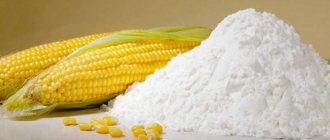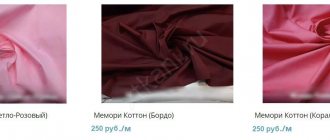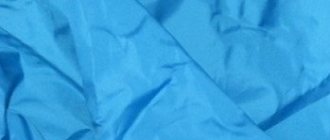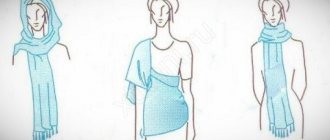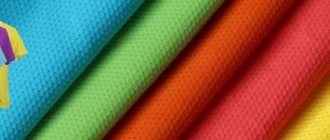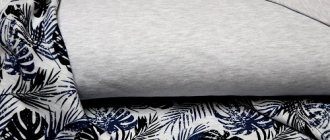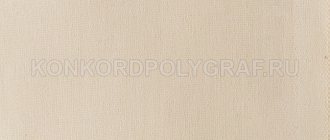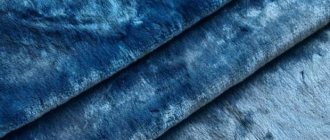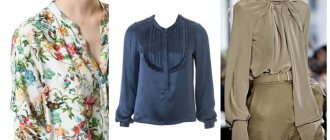Just recently I came across a photo of a stunning dress. You know, it attracted me with its unusual colors. The abundance of colors mixed with each other, reminiscent of an oil painting. Will such pretentiousness seem completely absurd and bad taste to you? But I dare to assure you - it’s wonderful! To better understand, I started looking for information on what this color ratio in clothes is called.
Dégrade or ombre is the name given to the effect of a smooth transition from one color to another.
History and description
What is degrade fabric? At first glance, it looks like this material has faded in the sun or faded during washing. Actually, this is how it used to be - the technique of degradation on fabric appeared in the 70s, during the hippie era. Original items were then created at home - knitted clothes were tightly twisted or tied and dipped in dye. However, today the dyeing technique has been brought to perfection, and things made from this material seem to acquire additional lightness and airiness.
Dresses made from degrade fabric were presented by the most popular fashion houses such as Prada and Givenchy.
Fabric with a degraded effect can be of completely different colors, even, at first glance, incompatible. The main condition is the transition from a light shade to a dark one or from dark to light.
The price per meter depends on what kind of canvas the dyeing technique was used on and starts from 800 rubles.
You can see what material with a similar color effect looks like in the photo.
Now let's move on to a detailed study!
Gradient clothing gained its popularity back in the 70s and 80s, among hippies. Creative and courageous youth sought to show their protest against the gray world. She was ready for new colors and new impressions, while not being embarrassed by her views. Want to know more about this?! Then read the article about hippie style at this link.
Previously, the smooth transition of color looked like a sun-faded item, but now it has become a more complex transition of colors, creating a luxurious item.
After some time, degradation returned to the podium again:
Famous designers began to use the degradation effect not only in clothes, but in shoes and accessories (from bags to gloves).
Nowadays, the graduated transition technique surprises with its variety of colors and use of texture.
Fabrics used:
- silk;
- chiffon;
- knitwear;
- especially relevant for skin;
- fur;
- varnish.
Clothes mainly:
- long dresses and skirts;
- cardigans and long sweaters;
- trousers and shorts;
- vests, jackets and tops.
Kinds
Let's first figure out what fabric can be used for a dress with a degraded effect:
- Atlas. Both from natural silk and linen with the addition of cotton and synthetics.
- Knitwear. This fabric is durable and wear-resistant, and dyes well. In addition, its price is not high.
- Chiffon. Items made from degrade chiffon look especially airy, since the material itself is light and translucent.
- Cotton. Just like knitwear, wear-resistant and dyes beautifully
- Silk. Quite an expensive option, but it should be noted that degradation on silk looks especially impressive.
Not only the materials differ, but also the methods of painting them:
- The main method is to use one color, when the canvas, which is absolutely snow-white on top, acquires a rich, deep shade towards the bottom.
- Printed design. In this case, the shade of the pattern applied to a plain canvas changes from dark to light.
- Layering. The desired effect here is achieved by layering many layers of transparent material, which, in turn, is painted in shades of different saturation.
- Use of decorative materials. The method does not apply to coloring. The transition from light to dark or vice versa is achieved here by decorating the item with rhinestones, sequins, and other decorative elements of different shades.
Where is Degrade used?
Currently, color transitions are a sign of style and originality; they are used in clothing for any purpose. Traditional degrade chiffon is ideal for light dresses - both ballroom and promenade; knitwear with varying colors looks creative and elegant. In hand knitting, the degradation effect is considered one of the most common and simple technological techniques, which practical needlewomen readily use to recycle yarn residues.
Leading designers are constantly experimenting with this style. In addition to the traditional lightening of the main shades, transitions are used within the range of one color range, as well as between two different bright colors (for example, green and brown, neon and black). Brocade, leather fur in the degrade style look very original, as well as color changes not from top to bottom, but from left to right, creating fashionable asymmetry and optically narrowing the figure . Ample possibilities are presented by the play of colors on bedspreads, curtains, and household items.
Color transitions in clothing allow you to highlight the most attractive features of your figure and gently disguise its flaws.
The traditional light top of the dress is ideal for a pear-type figure; the dark shade at the top optically narrows the shoulders and widens the hips in a triangle figure. If you place dark areas along the waistline, then the “hourglass” effect is achieved even with an “apple” body type.
A scarf or cape with color transitions can play a significant role in correcting your figure, allowing you to hide excess volume and refresh your face. For a full figure, you should choose fabrics in soft, restrained shades with smooth transitions. In order for the degradation effect not to be distorted and not to play a cruel joke in visual perception, such a dress should have a minimum number of details.
Advantages and disadvantages
Pros:
- beauty
- Effectiveness
- Versatility
- Items made from such fabric do not require additional decorations
- In the case of natural materials - high environmental friendliness
Flaws:
- Any dyed fabric requires special care
- If the manufacturer has used a low-quality dye, the product can fade very quickly.
Advantages of technology
If you want to refresh your image a little and not change your image radically, then degrade is just what you need. Another advantage of this technique is that it looks equally stylish on both short haircuts and long hair, and it will suit all girls, regardless of body type and skin color. Fashionistas with dark hair should pay special attention to the degradation - this coloring is considered the most gentle for brunettes. Degrade also makes hair visually thicker.
Coloring using the degradation technique is universal and suitable for everyone who is looking for their own image and likes to experiment.
Application
Material dyed in this way can be used both to create everyday items or home textiles, and for going out outfits:
- Evening and cocktail dresses made of silk, satin and chiffon
- Sundresses, dresses, blouses, shorts, T-shirts, trousers and other items for every day in knitwear and cotton
- Swimsuits and pareos dyed this way look very impressive.
- Fabric for curtains with degrade is light and airy, similar to flowing water
- Their cotton fabric makes very original bed linen
Related materials:
Gradient | degradation effect | accent | gamma | color trends | bright shades | fashionable clothes | tights | contrast
Articles
- Advice from professionals. Stylish accessories: scarves, gloves, hats November 10, 2012, 13:30
- 6 star trends for autumn November 08, 2013, 00:00
- Patchwork: a bright autumn trend October 19, 2015, 07:00
Video
- Eye makeup with a natural effect from Sephora November 01, 2011, 01:00
- Urban Muse by Sisley October 09, 2013, 10:30 am
- Innovative lip products and new bright shades from SHISEIDO May 18, 2021, 10:00
Care
Here are the basic rules for fabric dyed this way:
- Carefully sort items before washing. Do not wash with darker items
- You need to wash either by hand or in a washing machine on a delicate cycle.
- If there is heavy soiling, first soak the product in soapy water.
- Washing temperature – no more than 30 degrees
- Since different materials can be dyed this way, carefully read the care instructions on the product label.
How to create a degradation effect with your own hands
The degradation effect can be achieved at home. It is best to apply paint to a finished product or piece of fabric, which should be light, clean and monochromatic. You can use brushes or a spray can as a tool. Before processing, the item or material must be secured to a wooden slats. It is best to use acid aniline dyes, but it is better to dilute them not with water (stains and stains may appear), but with a concentrate diluted with water in a ratio of 1:20.
Before you start painting, you need to soak the material with clean water. Because fabric does not dry as quickly as paper, you can achieve a smoother, more gradual transition.
It is better to start with a lighter shade, gradually shading and adding darker paint. You can paint by lowering the product into a solution with paint, gradually increasing the time it remains in the solution.
To fix the paint, you need to wrap it in old newspaper or cotton cloth and roll it up so that it fits in the pan (you need to put a saucer on the bottom of the pan and pour a little water). The bag needs to be attached to the holder and hung on the pan so that it does not touch either the walls or the water, and boil at low temperature for about an hour.

